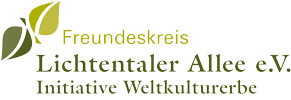
The Eden Bridge is part of Palais Biron. Here we have a good view of the park and the beautiful villa above the avenue. Halfway between the city and the Lichtental monastery, one enjoyed the advantages of a rural ambience and yet was close enough to the colourful social life of the city. It was the Frankfurt banker and court jeweller Carl Borgnis who purchased the Falkensteg estate on this site for his daughter and her husband Ernst Merck, a Hamburg merchant. The palace was designed by the Swiss architect Auguste de Meuron, who had already built the Thalia Theatre in Hamburg and whom Ernst Merck had brought with him from there. Villa Merck – as the palace was originally called – was completed in 1859. – The building cost exactly 127,655 courant marks! That was a considerable price at the time – even for a Hamburg merchant family of the Mercks’ stature.
But after all, Ernst Merck needed a prestigious property to receive his numerous guests and friends! It was not only guests from Germany and Europe who stayed with the Mercks! The Merck family’s guest book alone records 1,000 entries for the first three years: friends, business partners, politicians and artists. The house achieved particular splendour under Merck’s daughter Maria and her husband, the Austrian envoy Carl Pfusterschmidt Ritter zu Hardtenstein…… whose activities culminated in the social highlight of 1874: a visit by the Austrian Emperor Franz Joseph the First and his wife Elisabeth. The Empress travelled through the town in an open carriage on a late summer’s day in October. – The people of Baden-Baden stood on a guard of honour and celebrated “Sissi”. Empress Augusta and Grand Duchess Luise sat in the same carriage. Behind them in the carriage were the Grand Duke of Baden and the Hereditary Grand Duke and Emperor Wilhelm.
At the end of the 19th century, the Mercks withdrew from Baden-Baden and sold the house to the tobacco magnate Gustav Adolf Redwitz. A few years later, it became the property of Princess Biron of Courland. She gave the estate the name it still bears today.
During the Second World War, the building served as a military hospital for wounded German soldiers… And during the occupation of Baden-Baden by the French army, it was used by the French secret service – the “Sûreté Nationale”. A mysterious aura surrounded the former palace during these years when Baden-Baden was the capital of the French zone….
Today, the Palais Biron has become a business conference centre, probably one of the most prestigious in the whole of Germany. The Baden-Baden Chamber of Industry and Commerce took over the Palais Biron in 1956 and was later joined by the Baden-Badener Unternehmergespräche as a co-partner. Today, the top echelons of German business and politics come and go here. German chancellors have also been guests here: Konrad Adenauer, Ludwig Erhard and, more recently, Helmut Kohl, Gerhard Schröder and Angela Merkel.
Under the beautiful lime tree opposite the palace stands a bust of Robert Stolz! The composer planted the lime tree himself in 1971. It was an expression of his attachment to Baden-Baden and the Lichtentaler Allee. After all, his performances in Baden-Baden were among the musical highlights of the 1960s.






